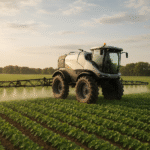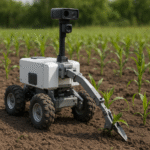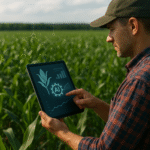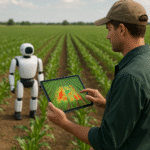Across expansive farmlands, weeds pose relentless challenges to crop efficiency and field management. Thanks to breakthroughs in automation and precision technologies, farmers can deploy intelligent systems for targeted weed control. This article explores the latest advances in Automated Weed Control, detailing how state-of-the-art vision, machine learning and robotic innovations combine to deliver sustainable, cost-effective solutions. From high-definition imaging to autonomous implements, these systems promise to revolutionize the agricultural landscape.
Smart Vision Technologies for Weed Identification
Precise discrimination between crops and weeds is the foundation of any intelligent removal system. By leveraging high-resolution cameras, multispectral sensors and advanced deep learning algorithms, modern platforms can achieve real-time weed detection and classification with remarkable accuracy. Convolutional neural networks and custom image processing pipelines analyze each pixel, differentiating between subtle leaf shapes and color variations under changing light conditions. Integrating multiple sensing modalities enables robust performance across soil types and growth stages, while onboard processors ensure minimal latency. Key innovations include adaptive thresholding, feature extraction modules and continuous learning frameworks that refine detection over time. These vision engines convert raw data into actionable commands for downstream applicators, forming the core of any intelligent weed control solution.
Image Recognition and Machine Learning Algorithms
Machine learning models trained on thousands of annotated images empower tractors and drones to recognize weed species in situ. By fine-tuning convolutional layers and optimizing hyperparameters, researchers achieve detection rates exceeding 95%. Transfer learning techniques further accelerate development by reusing pre-trained weights from related agricultural datasets. During field tests, edge devices process video streams to spot emerging weed clusters, triggering immediate corrective actions. Continuous retraining with new field data improves model resilience, accommodating regional variations and seasonal dynamics. Specialized loss functions help the system focus on small or occluded plants, ensuring even juvenile weeds are promptly identified.
Sensor Fusion and Data Integration
Beyond optical cameras, multispectral and hyperspectral sensors unveil vegetation indices invisible to the naked eye. By combining RGB with near-infrared and thermal bands, systems detect stress patterns unique to weed species, boosting detection confidence. Real-time fusion of GNSS positioning, inertial measurements and environmental inputs—such as soil moisture and temperature—enables context-aware decision making. The resulting geospatial weed maps guide targeted spraying or mechanical removal, reducing chemical footprints and preserving beneficial flora. Data aggregation platforms collect sensor logs, facilitating long-term trend analysis and assisting agronomists in fine-tuning crop rotations and soil management practices.
Robotic Platforms for Weed Removal
Once weeds are identified, the challenge shifts to efficient removal. Autonomous platforms equipped with precision applicators tackle weed patches with surgical accuracy. These machines range from compact field robots to heavy-duty tractors fitted with advanced actuators. Robotics innovations include electro-mechanical weeding arms, high-pressure water jets and localized herbicide nozzles that treat only the identified weed. By confining intervention to unwanted plants, overall herbicide usage can drop by up to 90%, aligning with modern sustainability goals.
Autonomous Ground Vehicles
Self-driving tractors and specialized weeding robots navigate through rows using guidance systems based on RTK-GPS and LiDAR. Equipped with modular weeding tools, they adapt to various crop configurations and row spacings. Mechanical weeder attachments use precision blades or rotating cultivator wheels to uproot or sever weed roots, while fluid nozzles deliver micro-doses of herbicide directly to the target. This hybrid approach combines mechanical and chemical control, maximizing efficacy while minimizing environmental impact. Onboard safety features, such as obstacle detection and emergency stop protocols, guarantee secure operation in dynamic field conditions.
Aerial Drones and UAV Applications
Drones equipped with sprayers and spot-spray mechanisms hover over fields, rapidly treating isolated weed patches. With flight autonomy tied to high-resolution drone imagery, these UAVs can cover difficult terrain inaccessible to ground vehicles. Emerging swarming strategies allow fleets of drones to collaborate, sharing mapping data and partitioning fields for parallel operations. Ultralight drones equipped with mechanical micro-weeders show promise for inter-row weed management in high-density planting schemes, reducing soil compaction and avoiding disruption to crop canopies.
Environmental Impact and Economic Benefits
Targeted weed control systems deliver measurable benefits for both ecosystems and farm budgets. By eliminating blanket spraying, these solutions preserve soil health and protect non-target organisms, such as pollinators and beneficial microbes. Field trials report up to 70% reduction in herbicide consumption, contributing to cleaner water runoff and lower chemical residues. In parallel, farmers enjoy cost savings from decreased input expenses and improved crop yield. Optimized weed management also reduces labor demands, freeing staff to focus on higher-value agronomic tasks. The net result is a virtuous cycle of enhanced productivity, ecological stewardship and economic resilience.
- Reduced herbicide usage by up to 90% through selective spot treatment
- Crop yield improvements of 10–20% due to minimized weed competition
- Lower labor costs and faster field operations enabled by autonomous machines
- Decreased CO2 emissions via efficient fuel consumption and optimized routes
- Improved soil quality secured by preserving beneficial microorganisms
Future Directions and Challenges
Despite significant progress, obstacles remain on the path to fully autonomous weed control. Rugged terrain, variable weather and evolving weed genetics demand continuous system adaptation. Ensuring reliable operation in dusty, muddy or low-light conditions requires robust hardware designs and advanced fault-tolerant software. Regulatory frameworks for autonomous chemical application are still evolving, adding compliance challenges. Future research is poised to explore collaborative robotics, where fleets of ground robots and drones cooperate in real time, sharing sensory intelligence to optimize coverage. Integration with broader smart-farming platforms will align weed management with irrigation, fertilizer and crop monitoring systems, ushering in truly holistic precision agriculture. As these innovations mature, they will redefine how we cultivate land, forging a more productive and ecologically harmonious agricultural future.










